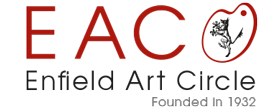Many EAC members and guests braved the cold and wet to attend the February meeting for a highly engaging talk, ‘Taking a Line for a Walk – A Short History of Drawing’ by artist and designer Mark Lewis.
The title was derived from a quote by Bauhaus artist Paul Klee: ‘A line is a dot that went for a walk. A drawing is simply a line going for a walk. Art does not reproduce what we see; rather, it makes us see.’
Mark took us on a whistle-stop illustrated tour, from the cave drawings of Lascaux through to the experimental approaches of the 20th century, showing the many ways that humans have used drawing to communicate since prehistoric times.
A look at the schematic, two-dimensional drawings of ancient civilisations such as the Egyptians and Greeks led on to examination of the artistic advances of the Renaissance, when the formulation of linear perspective and a fascination with the human form led to the full flowering of drawing in three dimensions.
We looked at the achievements of many great artists, such as Raphael, Michelangelo and Leonardo Da Vinci. The latter’s extraordinary output included not only some of the world’s most enduringly beautiful images, but also highly detailed scientific drawings recording the results of his anatomical dissections, and technical drawings through which he worked out his ideas for a multitude of inventions.
Artists such as Rubens and Rembrandt drew incessantly, capturing scenes of domestic and street life to leave a fascinating record of everyday life in the 17th century.
Even with the invention of photography, drawing continued to be an essential means for artists to explore the world around them. Degas and Toulouse Lautrec used rapid sketching to express the movement and dynamism of 19th-century urban society, with subjects such as the ballet, cabaret and horse racing.
In the 20th century, art turned inward to explore the workings of the mind. ‘Automatic drawing’ was a technique developed by the Surrealists, aiming to channel images from the subconscious directly through the artist’s hand, without interference from the conscious mind.
Gesture drawing is a technique that has developed in recent years, particularly in life drawing, where the artist records a series of fast poses using the minimum of line and tone to capture feeling, action and movement.
Although at first quite modern and experimental in appearance, the technique shows a clear line of connection, all the way back through the Renaissance, to the work of those first artists making images on cave walls, who sought to use the simple medium of line and mark-making to express the world around them.
www.marklewisart.co.uk
For more information on future topics, see Thursday Meetings

Recent Comments